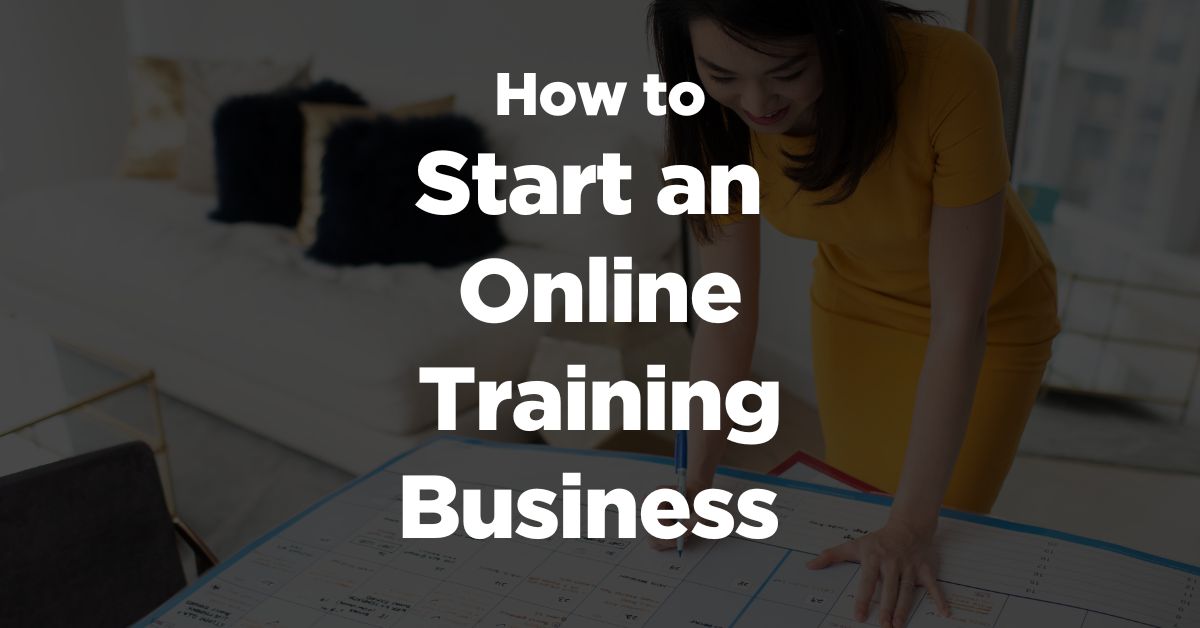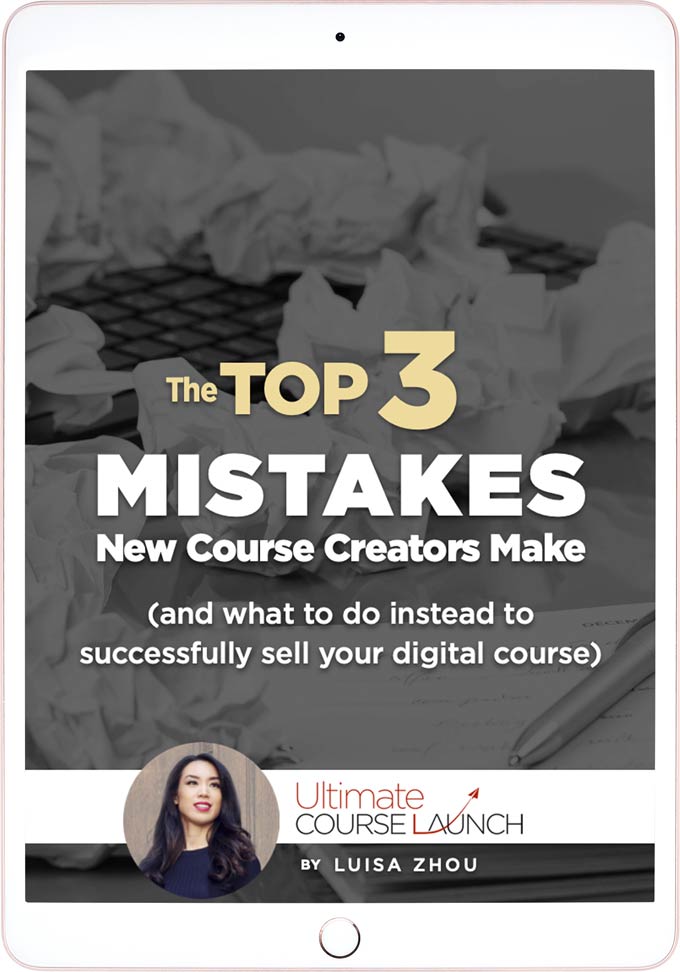Want to learn how to start an online training business?
You’re in the right place. Today, you’ll learn how to start your own online education business that’s both profitable and scalable.
Want to learn more? Read on!
What is an online training business?
An online training business, or an online education business, is a business that sells online courses. And these online courses are in demand; the industry is expected to become a $243 billion industry.
The thing you sell as a course creator is information, but in a way that helps people apply that information and get results—in other words, they buy the transformation that your information offers.
But what type of information can you sell?
Your training course can teach people information you’ve acquired as part of your job, education, or by yourself. For instance, if you’re a self-taught coder who has landed a job as a programmer, your education business can help people do the same. Or if you are into health and you’ve learned how to eat healthily, you might teach people who want to get the same results as you did.
Some real-life examples of training businesses are…
Good Gentlemen. My student Ruby helps men find love. Ruby worked as a matchmaker at companies like eHarmony before she started her own education business.

Cultivitae. My student Emily worked for years as a recruiter. And now, she helps people land their dream jobs.

Wisdom Square. My student David started experimenting with herbs to fix his own health issues. He discovered a way to use herbs to lose weight and that’s how Wisdom Square was born!

But how do you start selling courses? Let’s find out.
How to start selling online training courses
Now, there are a few ways in which you can get started building your online training business.
The easiest way is to FIRST start a coaching or a consulting business where you help people one-on-one. This will give you the skills to then teach them that same thing through an online education business.
The next option is a group coaching program, which means that you help multiple people simultaneously as a coach. A group program typically involves some kind of self-study course as well.
And the third option is self-study training courses, AKA courses that people take on their own. You usually don’t offer a lot of personal support when you sell self-study courses; in some cases, none at all.
The reason these courses aren’t the best place to start is that it takes some learning on your part to figure out what to include in your course, how to structure it, and how to deliver your content to help your students get results.
And the best way to learn all those things is to first work closely with them as a coach or consultant. So, that’s why I recommend that you start there.
But if you’re ready to sell courses, how do you make money in your business? That’s what we’ll look at next.
How to make money selling courses online
How do you make money as an online course creator?
There are a few ways you can sell your online course.
The first one is with a launch model.
This model means that you launch your course one to four times a year (or more). In between, people can’t buy your course. Instead, you build buzz with your launches so that people get excited to buy your course.
Now, I hear a lot of people say, “launches are dead.”
But contrary to popular belief, launching is as profitable as ever.
Especially for new course creators who still need to master things like sales and marketing. That’s why this is the route I recommend for you if you’re new to training courses.
The second model is evergreen courses. Evergreen means that you sell your course via an automated system that allows you to make sales all the time, “passively.” And a lot of people say, “evergreen is where it’s at.”
Except, they’re wrong.
Yes, evergreen works. My business is, in large part part, an evergreen course business.
But, it took me years to get here. First, I had to go through the grind and learn how to create the best courses possible.
Then, I had to build my traffic.
Contrast that to my launches. I consistently saw more engagement, generated more momentum and brand recognition, and built deeper connections with my audience than I could ever do through evergreen. (And I had a way higher sales conversion rate than I’ll probably ever have with my evergreen funnels, even though they’re incredible.)
So start with launches and then, once you have learned how to build courses, market, sell, and support your clients, turn to evergreen.
Now you know what it takes to make money with your courses. But how much can you make with a training course business? That’s what we’ll look at next.
How much can you make selling online courses?
Are online training courses profitable?
The answer is: Yes, online education can be one of the most profitable business models out there.
You see, once you’ve created your course, you own an asset that you can sell again and again without development or shipping costs.
Granted, you’ll have business costs. But so does every business—however, due to its relatively low costs, an online course business can be very profitable relative to other businesses.
Ultimately, there’s no income gap for making money with online courses.
Some people want to keep their online course income as a side business or as an extra income source. Others want to build a fully-fledged online course business and make six figures, multiple six figures, or seven figures from their courses. I’ve helped both groups of people start their online training businesses.
So your income potential comes down to your goals.
That said, if you want to start an online training business, how do you know that you’re qualified to do so?
Let’s take a look.
Who is qualified to run an online training business?
You might be wondering:
Who is qualified to teach others with an online course business?
Good question. There are no formal qualifications for online courses (at least most of them—some industries require certifications or formal training, mainly certain health-related niches. You need to be aware of any requirements in the industry you want to build a course business in).
You should have achieved what you teach, though. So if you teach people how to get abs, you should have built abs using your own methodology.
Or if you teach others how to get promoted at work, you’ve used your own system to get promoted.
In other words: If you’ve achieved results yourself, you’re qualified to teach them.
But how do you even find an idea? Build a course? And sell it?
That’s what we’ll look at next!
How do you start a profitable online course business?
How do you start an online training business?
Great question. Here’s how to build your business from having no course idea or audience to selling your first courses.
Read on!
Your online education business plan
What’s the first thing you should do to sell your course?
Finding a course idea, growing your audience, and selling your course… it all comes down to a few proven steps.
Here’s how to start an online training business:
- Brainstorm a course idea (strategically, so that you find an idea you like AND people want to pay for)
- Build your audience (in as little time as possible so you can start selling your course)
- Build your course (so that people enjoy learning from you and get results)
- Price your course (in the right way)
- And launch your course (with a proven, four-step plan)
Here below, we’ll look at each of these steps. First up: find your course idea.
1. Decide on an online course topic
Why do you need a niche to succeed as a course creator?
Well, whatever industry you’re thinking about, there probably are tons of businesses in that same industry… That’s what a niche will help you with; to stand out.
But how do you find your niche?
First, brainstorm all the categories you could start your online training business in. These can be based on your existing skills or job experience.
Then, think about each category and what things you’d talk about and give people advice on. There’s likely one niche that trumps all others and is much easier for you to talk about… that’s a great niche to get started in.
Next, think about who you can help with that topic. And not just anyone, but who are the people who are willing and able to pay for your help.
Finally, who is likely to relate to you and for that reason, more likely to hire you?
(These are usually people who share your characteristics, such as middle-aged women if you’re a middle-aged woman. Note that you don’t have to have the exact same characteristics, but it’s much easier to sell to people who already relate to you from the start.)
Then, name the problem you help solve. What do your potential clients want? To get ahead in their careers? To build muscle? Or to learn how to code so they can land a new job?
In this short video, I share more about what it takes to find your niche:
Now that you know how to find your niche, let’s take a look at what you need to know about building an audience.
2. Understand and build your audience
Most online business gurus tell you to spend YEARS building an audience before you sell a thing.
I’m firmly against that. You don’t have to spend months or years building your audience, but you can instead build a small audience right away, sell your product, and build a bigger audience as you build your business.
Building your audience comes down to getting people to find you through different strategies and then inviting them to join YOUR audience by signing up for your email list.
But why ask them to join your email list? Why not just ask them to follow you on social media?
Simple: you own your email list. It’s your asset. But a social media audience is owned by the social media platform and they can do as they please, be it shut down your account or change their algorithm so that people won’t find you anymore.
Plus, email just has a bigger ROI (for every $1 spent, marketers make $42).
That said, growing your email list is more about quality than quantity. Don’t just “spray and pray” by doing as much as possible, but focus on a few, high-quality strategies.
Some of those strategies include getting on podcasts as a guest, guest posting on other websites, and growing your audience on a social media platform (such as Instagram, TikTok, or LinkedIn).
By following these steps, you can get started really fast. That’s because you don’t need thousands of people in your audience, especially if you follow my launch strategy, which I share below.
Even a few hundred people is enough.
That’s how Lisa S., an advertising consultant, sold her online course with just 100 audience members.

And Lisa, a fitness coach, sold out her bootcamp!

But how do you create your training course? Let’s take a look.
4. Build your course
Now we’re getting to the really fun part!
Your next task is to decide what type of course you want to sell.
Let me explain:
There are two types of courses you can sell.
Either a group program where you give more private support or a self-study course, which people go through on their own.
The course you decide to build depends on a few factors, such as if this is the first training course you create. If it is, a group coaching program might be the right choice for you because you will be able to give more support to your clients and help them get results, while there’s a learning curve to teaching a self-study course.
Either way, the easiest way to get started is to first coach or consult and then create a course based on your existing methodology. Once you’ve coached one or two people, you’ll start seeing patterns; what questions they have and when, what objections or challenges they have, and so on.
Here’s what’s required to build both types of courses:
Group coaching program
A group program is a program where you coach many people simultaneously. Your program can either be an intimate group with up to 25 participants (which is a higher-end offer) or a program with 300-400 people (in which case you’ll probably offer a self-study course together with live support).
To create your group coaching program, ask yourself:
What is going to be the promise of your group program?
How is the delivery going to match the promise?
And what is the depth you’re going to go into for customization?
These are all important to consider because you don’t want to end up in a situation where you have promised too much and struggle with fulfilling those promises.
Or where you have a mishmash of coaching calls. You do need a structure so that you can deliver what you promise to your students.
That’s what you need for a group program. And here’s how to create a self-study course:
Self-study course
To create a self-study course, either to sell on its own or as part of a group coaching program, ask yourself:
What are the results someone will get after going through your course?
The thing that makes a course great isn’t all the features or things people get (50,000 hours of video, 20 PDFs and so on). Nope, what makes a course great is how it helps students get the best results possible in the shortest amount of time or the most efficient way for them.
And that also means you shouldn’t start with a massive course, but instead, the first steps someone needs to take to get results. Let me explain.
Create a First Steps course
Lots of people create a Magnum Opus right off the bat and try to include everything they know into one course.
However, that’s not how it works.
When you create your first course, you should create a much smaller course. This course will teach people to take the first few steps to get the ultimate result they want.
If you’re a health coach, you could teach people how to meal prep healthy food (instead of the ultimate result, which might be to lose more weight or get a toned body).
I first created a course called “Your First Paying Clients” before I created my flagship course “Employee to Entrepreneur”. YFPC teaches people how to get their first clients, while ETE teaches people how to build a business from A to Z. It would have been really overwhelming to create a course about building a business from scratch before I had learned to create a small course.
Over-communicate
Over-communicate in your course. Tell people: what’s the plan? What steps are they taking now? What are they doing next? In other words, for each lesson, tell people what they’ll learn in that lesson, go through the content, and then explain what the next steps are.
Set up your course
Where should you host your course? The easiest way is to set up a private Facebook group or similar and invite your students to this group. You can add videos and Google Docs to the group (this doesn’t have to be fancy to keep things as simple as possible).
That’s how I created my first course. Not only was it the easiest way for me to get started, but it made my course feel really intimate and helped me support my students so that they got better results.
However, you can also host your course on a simple WordPress site or an online course platform like Teachable. These aren’t as lean as a simple Facebook group, but they work just as well.
Support
Before you launch your course, you will need to decide on the amount of support you’ll offer your students. In the beginning, you won’t get far if you just launch your course and sit back and relax. Instead, by actively supporting your students, your course stands out AND you learn more about your students and how they learn from your course.
In my first years, I live coached over 1,000 students before I felt comfortable that my flagship course included everything it needed to and was structured in a way that made it easy for my students to implement it.
During this time, I added a lot of coaching support (first, just my own support and later, I added on program coaches to offer even more support). And thanks to this support, my students got the best results possible.
That’s it for creating a successful course. If you’re curious about learning more about course creation, I explain the process in a bit more detail in this video:
But how do you decide on a course price? That’s what we’ll look at next.
3. Decide on your course price
Your course price depends on the course you sell.
If your course is a group coaching program with one-on-one support, you can price your program at $997-$1,997. Once you’ve worked with a few students, you can raise your rates to $2,997 and more.
Or if your course is a self-study course, your price could be between $197-$497. When you have testimonials and a more established online education business (AKA you know how to create and sell courses), you can raise your price to $1,997 or more.
And when you’ve created your course, it’s time to… launch it!
5. Launch your course
First, we need to bust a popular myth in the training business industry.
That you create your course, write a few sales emails, and then you sit back and watch the “passive income” roll in.
At a certain point, that is what can happen.
In my business, that’s how we make most of our income. But I’ve also built a massive email list and have been doing this for seven years.
I didn’t have any of this starting out, as you probably don’t, either.
You might have just a few hundred people in your audience (if even), you probably don’t have marketing and copywriting skills, and people don’t know you that well.
It’s a completely different ballgame.
That’s why, to sell out your first few courses, you need to use a strong launch strategy and a good amount of hustling.
Here’s what I mean:
When I launched my first course, I made $8,000, which meant about 16 course students.
To get those students, I talked to about 40 people. Every person who joined my course had personally spoken to me. They would probably not have joined by just reading a few emails because I wasn’t that good at writing sales emails.
Plus, as you launch, you ALSO grow your audience, which helps you in your next launch. So, it gets easier and easier (during my next few launches, I made several hundreds of thousands in sales).
But before you’re more established and people know about you and your course, you will need to put in skin in the game.
The launch strategy I use for online course sales has four stages:
#1: The pre-launch
This is the time before your launch where you’re building your audience and letting people know you have a course coming in the next few months.
I used social media when I built my first course. Through my own Facebook group, people started finding me and recommending my course to their friends.
While I had started from zero, I soon had a few hundred group members on the platform by showing up every day and grinding and hustling to get in front of my audience.
#2: Launch triggers
Because your audience is super busy and sees tons of ads and emails every day, you really have to stand out to get their attention and sell your course.
That’s where a launch trigger comes in.
It’s an event that grabs your audience’s attention and makes them excited about your upcoming course.
The launch trigger I prefer is a live challenge.
For your first course, I recommend a live challenge of about five days where you challenge your audience to take action and then you give them live feedback, share content, and use livestreams to connect with your audience.
In other words, you’re essentially showing people how good you are at what you do and building trust so that they feel more comfortable and excited about buying your course.
#3: The launch
The third phase is the launch itself.
Now, you don’t want to think, “The cart is open! I’m going to send a few emails and that’s it.”
This would be a mistake and you might lose out on plenty of sales.
Instead, get out there and make the most of this time. There will be a lot of people who are seeing you talk about your product and they might be interested but on the fence about buying the product.
If you don’t reach those people, they likely won’t buy.
But if you’re out there, posting, sharing value, and connecting with people, you’re inviting people who are interested to chat with you about whether your course is a good fit for them or not.
After all, the reason people choose you instead of an established course creator is that you take the time to connect and talk to them.
#4: Post-launch
This is the phase most course creators get wrong.
They think this is where I get to sit back and relax.
But the post-launch phase is actually where the work builds.
After you’ve created and sold out your first course or group program, that’s when you get to reap even greater rewards, such as leveraging the momentum and learnings from your first launch to do a bigger second launch (with a lot less work because you’ll have assets and experience).
It’s the phase where you can be delivering so much additional value by supporting your students and using their feedback to improve your course.
Your students, in turn, get the best results thanks to your support and come back with testimonials, which help you grow your course further.
Also, at this point, some students will want more after going through your course.
By talking to these students, you could get new course ideas, sell coaching or consulting offers, or get even more testimonials.
And it can really pay off… This is the strategy I used to add $20,000 to my $8,000 course.
In this video, I show you what the process looks like:
Ultimately, the success of your launch depends on how well you turn strangers into excited customers.
6. Market your course
The strategy I recommend that you follow is to grow your audience with one or two audience-building techniques (the ones we talked about earlier; podcasting, guest posting, building a social media audience, and so on). You might also grow your audience with more scalable strategies, like social media ads.
In between, launch your course throughout the year.
This is the strategy I used to grow my business to multiple seven-figures.
After my $8,000 launch, I had a $100,000 launch. And after that, an $800,000 launch—and a seven-figure year thanks to the coaching I sold beside my self-study courses.
When you’ve built an established training course business, you can scale it further and move to a more evergreen business model. Once you’re at this point, you can use a highly scalable marketing strategy like search engine optimization to grow your business further.
That’s also how I grew my business to a “passive income” model (note: no income source is completely passive). Once I had grown my audience with launches, social media, and Facebook ads, I turned to more evergreen strategies such as SEO and YouTube.
And that’s how you build a highly profitable online training business, which offers freedom, flexibility, and a way to provide value to as many people as possible.
Next steps
There you have it! Now you know how to start an online training business.
What it comes down to is that you focus on the essentials: Finding a niche, focusing on one or two audience-building strategies, and launching your online education course.
At the same time, I’ve helped hundreds of people start their businesses. And there are a few mistakes new course creators tend to make that keep them from creating a successful course business.
Want to know what they are?
Get my FREE PDF with 3 deadly course creator mistakes (so that you avoid making them).









2 Responses
Great article. I LOVE this line “ they buy the transformation that your information offers”. Thanks for such an inspiring article.
You’re welcome!